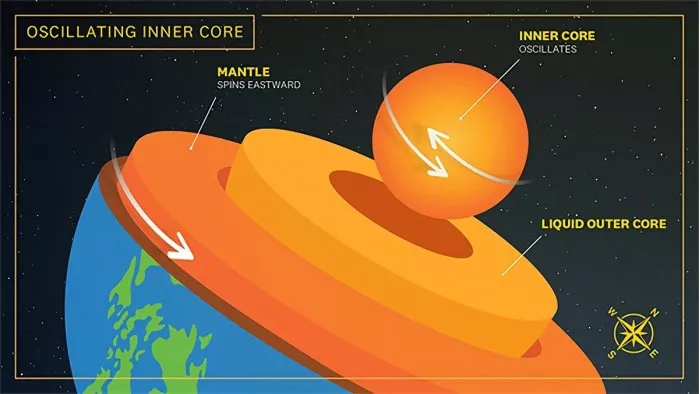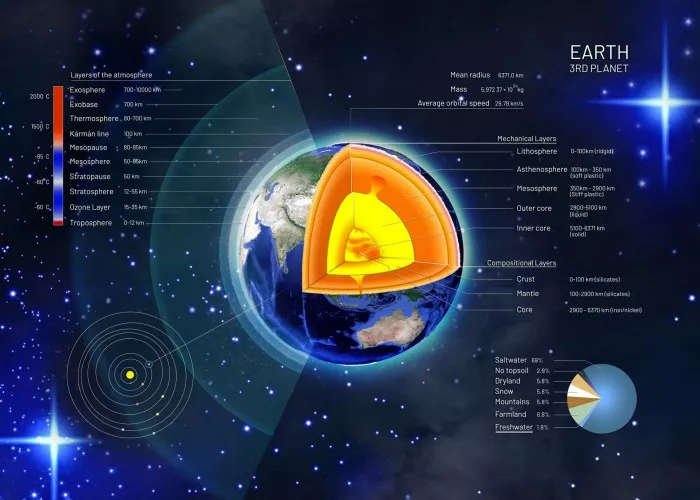Based on their analysis of the seismic data, the scientists identified a six-year super and sub rotation period that affects the length of a day. The structure of the earth is divided into several layers, with the core at the center, followed by the outer core, lower mantle, upper mantle, crust and atmosphere. The core is the hottest part of the earth, with a temperature of about 10000 ° f (5400 ° C), which is similar to the temperature of the sun's surface. The core is the hottest part of the earth.

It is believed that the earth's core is mainly composed of iron nickel alloy. It is mainly a solid ball with a radius of about 760 miles (1220 kilometers). Its rotation speed is slightly faster than that of the planet, which is called super rotation. Scientists at the University of Southern California (USC) have found evidence of oscillations in the earth's core, which contradicts previously accepted models that believe that it always rotates faster than the earth's surface.
Their research was published in the journal progress of science today (june10,2022). It shows that according to the analysis of seismic data, the core changed direction during the six years from 1969 to 74. The scientists say that their model of core motion also explains the variation of the length of a day. In the past few decades, the length of a day has been proved to be continuous oscillation.
"From our findings, we can see that the earth's surface has changed compared with its core, as people have asserted for 20 years," said John E. Vidale, co-author of the study and professor of Earth Science at the dornsife School of literature, art and science at the University of Southern California. "However, our latest observations show that the rotation speed of the core was slightly slower in 1969-71, and then moved in the other direction from 1971-74. We also note that the length of a day increased and decreased as predicted. The coincidence of these two observations makes it possible to explain the oscillation.".

Earth's oscillatory core: researchers at the University of Southern California found a six-year super rotation and sub rotation cycle in the earth's core, which contradicts the previously accepted models, which believe that its rotation speed is always faster than that of the earth's surface.
The analysis of the atomic test determines the rotational speed and direction
Over the past 30 years, our understanding of the kernel has greatly expanded. The core, a hot, dense, solid iron ball the size of Pluto, has been shown to move and / or change over decades. It is also impossible to observe directly, which means that researchers try to explain the patterns, speeds and causes of motion and changes through indirect measurements. Research published in 1996 first suggested that the core rotates faster than the rest of the planet -- also known as super rotation -- about 1 degree per year. Vidal's subsequent findings reinforce the idea of kernel super rotation, albeit at a slower rate.

Hierarchical structure information map of the earth
Using data from the large aperture seismic array (LASA), a US Air Force facility in Montana, researchers Wang Wei and Vidale found that the rotation speed of the core was slower than previously predicted, about 0.1 degrees per year. Using a new beamforming technology developed by Vidale, this study analyzed the waves generated by the Soviet underground nuclear bomb test conducted in new yazemlya, the Arctic islands, from 1971 to 74.
When Wang and Vidale applied the same method to a pair of early atomic experiments under Amchitka island at the top of Alaska islands, new discoveries emerged -- milrow in 1969 and cannikin in 1971. They measured the compression wave generated by the nuclear explosion and found that the inner core had reversed its direction, rotating at least one tenth of the time every year.
This latest study marks the first time that the famous six-year oscillation has been confirmed by direct seismological observation.
Vidale said, "the idea of kernel oscillation is an existing model, but the community has been divided on whether it is feasible. When we entered the project, we expected to see the same rotation direction and speed in the early pair of atomic tests, but we saw the opposite. We were quite surprised to find that it was moving in the other direction."
Future research will dig deeper into the causes of kernel formation
Vidale and Wang both pointed out that future research will depend on finding enough accurate observation data to compare with these results. By using seismological data from atomic tests in previous studies, they have been able to determine the exact location and time of very simple seismic events. However, Lasa in Montana was closed in 1978, and the era of underground atomic testing in the United States has passed, which means that researchers need to rely on relatively inaccurate seismic data, even with recent advances in instrumentation.
This study supports the speculation that the core oscillates according to the variation of day length - plus or minus 0.2 seconds in six years - and the geomagnetic field, both of which are consistent with theory in terms of amplitude and phase. Vidale said that these findings provide a convincing theory for many problems raised by the research community.
"The kernel is not fixed -- it moves under our feet and seems to go back and forth a few kilometers every six years," Vidale said. "One of the questions we're trying to answer is, does the kernel move gradually, or is it mostly locked for a long time compared to other things? We're trying to understand how the kernel is formed and how it moves over time -- an important step in better understanding this process."